Embracing the Moment - Are You on the Dance Floor?
I was just listening to an interview about a survivalist who spent time living with people who lived off the land in northern Russia. Every day, all their activities went to finding food and to do what they had to to survive – even when the weather was extreme, or they were hurt or sick. He came away from the experience convinced that we are made for this nomadic, tribal way of life – that we are at our best when we are knowledgeable and productive, and in touch with nature.
It caught my attention when he said that these people were happy, despite the hardships, and genuinely were in a state of gratitude, most of the time. Now, we hear about gratitude all the time, and its importance as a life principle that allows you to fully embrace whatever your reality is, and to find something to appreciate and enjoy. And sometimes it comes down to appreciating and embracing fresh air and open spaces, on a cold and rainy day.
Makes me think about the kid at a family wedding - when a great aunt wants to drag her onto the dance floor as the polka music or the chicken dance strikes up. The choice is to resist for fear of being embarrassed or to embrace the moment.
Whether it’s a family wedding or a challenging situation, the only way to give yourself access to enjoyment - to creativity, invention and resilience - is to choose to fully embrace whatever is happening. You’ll notice that your energy shifts dramatically as you rise to the challenge, and you’ll be so grateful that you did.
It’s been spectacular to watch companies jump onto the dance floor of life in this rich, creative time as their survival instincts have kicked in, and to witness their innovations and inventions.
In a conversation with friends over the weekend we talked about why some people are doing well, and some are beaten down by what’s happening now. The common thread is allowing the entrepreneurial spirit to rise, a can-do attitude and willingness to embrace the situation and to find new opportunities.
Whether you’re in the wilds of northern Russia or responsible for running a company in the city, humans are truly at their best when challenged, focused, creative and resourceful. Sometimes, it’s a matter of survival, and sometimes, it’s pure fun.
The Challenge
- Where are you resisting - in your business or your team – being dragged onto the dance floor?
- What exciting opportunities do you need to stop resisting and find a way to fully embrace?
Scenario Planning for Sanity in the Middle of Chaos
The first six months of this year have sure been different than almost anyone would have expected.
Many people are settling down and can see a path forward, although there’s incredible uncertainty in terms of what the next six months will look like:
- Is there going to be another round of this virus?
- What's going to happen to the economy?
- How are we going to interact with humans in the workplace or in public?
- How you plan effectively when in the middle of chaos?
The reality is that there's always potential for a degree of chaos around the corner - it just feels very different when you're right in the middle of it.
So how do we thrive in times of uncertainty, and how do we plan? We need to be better prepared and to plan better. Here’s one of my favourite quotes:
“Victorious warriors win first and then go to war, while defeated warriors go to war first and then seek to win” - Sun Tzu, The Art of War
Because there are many different scenarios that can play out, having done your best planning helps you anticipate many of them - and the ones most relevant to you. But no matter what, you need to remain agile and able to adapt quickly to different circumstances.
The ABC's of Planning
When people talk about Plan B, they usually mean a back-up plan for when things don’t go well. But I believe you need to have a plan for when things go well so that you are ready to move on opportunities. You need Plan A, B and C, so as you reflect on your plan for the next quarter, and set goals that are the most important, think about all three versions:
- A - Accelerated - When things go in your favour
- B - Baseline - Your best guess of what’s going to happen
- C - Cautious – When things don’t go as well.
There’ll be triggers - for example, needing to hire more people or decreasing staff, buying or reducing inventory, payments to creditors or issues with your next acquisition.
And always know your direction and aspirations, the vision that drives you: your purpose and BHAG (Big Hairy Audacious Goal, à la Jim Collins) that give you calibration and point your mind in the right direction.
So, you have a strategic plan that fills the gaps in between, and right down to what you are going to do on a quarterly basis. You just need the ability to scale your plans up or down based on what actually happens over the next six months in order to manage your businesses properly.
It's about operating with more options built into your plans.
That said, staying nimble with your plans is more important. Working with many great entrepreneurs, I've noticed that many of them like to let the system run loose - meaning that they have a plan, but they always have a couple of doors open, in different directions, so that they can make changes very quickly.
They and their teams are very committed to the plans they have on annual, quarterly and sometimes monthly basis; but if there’s a willingness to change direction or decisions, they are prepared and willing to make those calls.
One of the companies that we work with has been very, very fortunate so find some tremendous opportunities in the middle of this COVID chaos. Because of how their business is booming, they are able to hire more people, but they’ve taken a different approach. Normally, when they hire people, they expect them to work for three, five or 10 years. Now, they're hiring people with the expectation that it could be three months - or three, five or 10 years. Meaning that they are gearing up to be much more flexible, based on what changes in the marketplace.
This is also why many people move to outsourcing, temporary employees or other flexible models, which allow them to adapt quickly.
Another client needed to lay off people and now, as their business is coming back and getting better, their short-term plan is to not hire people back, yet; but to find additional productivity and efficiency. They are offering more work to their existing team – either paying them overtime or giving them additional time off in their slow season. And their team is much more creative, naturally putting more energy into things that matter most, letting projects slip in the nice-to-do category or busy work. If the market changes or their business slips, they don’t have to lay off, again, because they know it’s hard on their culture.
The Challenge
- Set aside an hour or two to do your Quarterly Review and Plan, take a look at your Master Plan.
- Remind yourself what's most important and then go reset your goals for the quarter, applying the ABCs as needed.
The Power of Positive Programming
In the last few blogs, I’ve written about staying on the same page and reinforcing and strengthening culture and goals. Another key ingredient to success is to become a broken record.
To excel at any sport, you don’t just need to know what to do, you have to practice it again and again and again until muscle memory does the work automatically. The power of repetition puts you on effortless autopilot.
The same with math in school: saying the times tables again and again makes it automatic. When someone asks you, decades later, “what is 9 x 9?” you instantaneously know the answer is 81. It’s burned into your mind.
Same goes for repeated prayers. Or a popular jingle: you can hear the first few bars and finish the rest.
If it works in sports, math, religion and advertising, why not use the same principle in business?
As a CEO or leader, your goal is to figure out what people need to have top of mind and then to repeat it again and again and again so that the whole organization is automatically in sync.
I call this Positive Programming. And most organizations are horrible at it because they always focus on the next thing. You want to apply positive programming to a few tangible things:
- Values, purpose and BHAG - by CEOs, executives and team leaders. You can even make them the default in the first few slides of all your PowerPoint presentations
- Company goals
- Key systems, beliefs and habits that create amazing customer experiences because, at the end of the day, the customer is always the boss and there are things we can do to delight or drive them crazy.
Some examples:
- Retail companies use the ART of selling to take care of the customer and increase sales:
- Approach
- Recommend
- Thank
- One organization has their seven steps to SERVICE
- A professional services company focuses on excellence using GREAT
- A valet parking services business uses a calendar of the 31 behaviours every associate is expected to understand and deliver. Every day, every team at every location looks at the calendar and talks about the daily principle, to keep it top of mind. Over the year, every employee will hear every principle many times. With lots of turnover, it becomes training about what matters most – again and again and again.
People often believe that the work lies in defining a policy or procedure. But the real work is bringing the greatness behind them to life – and you can only do that as a broken record.
And when you’re made fun for doing that, and when people start saying “I know” or automatically finish your sentences or key phrases, you’re almost there.
The Challenge
- What are the three or four things you and your organization need to repeat this year - again and again and again?
Need help figuring out what to say again and again and again? We can help you with that!
Opportunity Evaluation - Pennies, Nickels & Dollars
Recently, we shared the 4 Forces of Growth model from my upcoming book The Gravity of Growth to help you to get perspective on where you spend your time and energy, in a business that aspires to keep growing. The model helps you to master how to prioritize and focus on what matters most.
To keep a company growing, you need to put some energy into growth thinking and growth activities, and those are normally found at the intersection of opportunities and courage. Seeing:
- New opportunities for existing customers or
- New customers in existing markets or
- New markets for existing products or services or
- New products and services…
…and then having the courage to test the market, see how it responds and continue to iterate based on what you learn.
We now want to help you decide which of the opportunities you should actually spend the time chasing – either in the growth or improvement quadrants of the business – which we like to look at through the lens of Pennies, Nickels and Dollars.
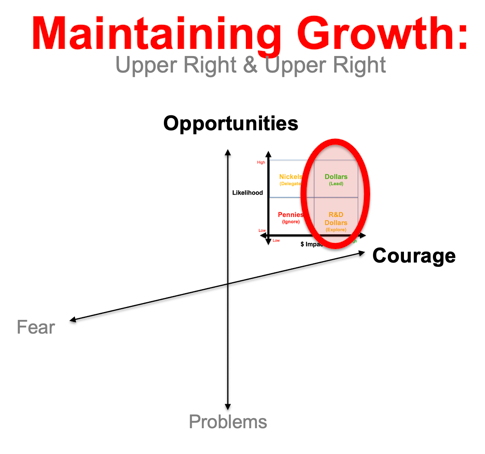
The Perspective
The challenge for many leaders is that when we get very busy, we become very passionate about problems or opportunities that we see and lack or lose perspective to discern the magnitude of the impact of these issues. We can be pulled into thinking that all problems need to be solved and all opportunities are worthy of being pursued.
Unfortunately, we often find ourselves stepping over a dollar to pick up a nickel, not realizing what we are doing. Ideally, we want to step over the nickels to focus on the dollars.
Energy and resource allocation - capital or human - is one of the most important jobs of a leader. It’s very challenging, sometimes impossible, to get right - unless you have the tools to make better choices.
One of the hardest parts of our job is to have the right perspective and tools so that we can step over the pennies and the nickels and to make sure we're picking up the dollars. That's not to say that somebody shouldn't pick up the nickels, but we need to make sure people don’t miss the dollars because of their obsession with nickels and that those don’t take a dollar’s worth of effort.
One CEO I spoke with recently said that some of his people were looking at trying to manage their line item of rent. After the CEO did the math, he said that if they allocated the executive time to come up with a strategy to support more work at home and other initiatives, they might have a savings of half of 1% of revenue – and that might be a notable savings. His stance was that they would be better off using same amount of organizational energy in initiatives to grow revenues by 10% or 15%. In this case, they’d be far better off not working hard to save the money on rent, if it takes executive energy away from the more impactful effort of increasing sales.
Now it does depend on the context of your business, but the key is to get the discipline to breakdown the ideas to know if they are worth a penny, a nickel or a dollar before people get too excited and invest precious resources in them.
All Opportunities Are Not Equal: Likelihood & Impact
Opportunity evaluation using the the Pennies, Nickels and Dollars Model helps you to evaluate an idea by looking at the likelihood of success, and the size of the dollar impact:
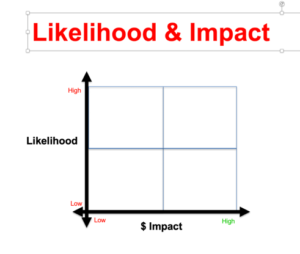
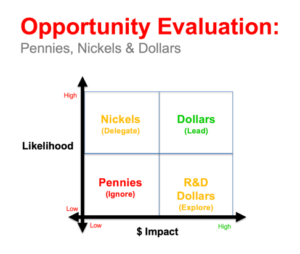
- Pennies box ideas should generally be ignored because there’s a low impact and low likelihood to capitalize. These are the ideas we ideally stop or ignore and nobody in your business should invest more than 30 seconds of time here. Now, if something in this quadrant happens with no effort or on its own, excellent.
- Nickels quadrant ideas have a high likelihood but a low dollar impact - something a CEO or executive shouldn’t spend any time on. Saving money is great discipline and these should be dealt with by the right people in the organization based on the magnitude of the impact.
- Dollars quadrant ideas have a high impact and high likelihood of success. They're good investments that obviously need some work and due diligence to prove their worth. Just make sure that you're just not kidding yourself if, in reality, they are riskier than anticipated.
For example, a CEO who spoke to us about international expansion said they've been thinking about it for a few months, and talking to lots of people who have expanded into the same country. He needed a few more months to consider if the business was actually capable of make it work, and if he was personally up for the challenge because he'd likely have to move.
A disciplined approach is needed to confirm a high likelihood of success – and worthy of dropping into strategic plans for key leaders in the business to drive. But only if there’s enough return to justify the executive team’s effort. This is where you want to focus.
- R&D dollars quadrant ideas are very high impact but low likelihood, and often people step over these because they don't know how to make them happen. These can be some of the biggest wins for companies, but they require a lot more work and testing – like in the mining world when they drill test holes to see the concentration of what’s under the surface, to determine if an operation can be profitable.
In many ways, this is what needs to happen here. It can be very, very high value for leaders to spend time doing additional R&D - to dedicate a percentage of their budget to explore and find ways to decrease the risk of these high risk/high reward programs.
Jim Collins describes this as the need to shoot a number of little bullets - a number of micro-tests they can afford to not work, in terms of organizational energy or capital – in order to learn more and find how to make these potentially come to fruition. These are often big wins on which people don't spend enough time because we’re so focused on short-term results and don’t have enough time for strategic thinking exploration.
Key points:
- Use the Pennies, Nickels, Dollars Model to evaluate the ideas that excite you most
- Make sure that the appropriate ideas, get the appropriate investment of time and resources from the right people
- Make sure the most senior people spend the right amount of time on Dollars and R&D Dollars,
and a mechanism (weekly or monthly meetings) to continue to evolved their thinking and progress on these ideas
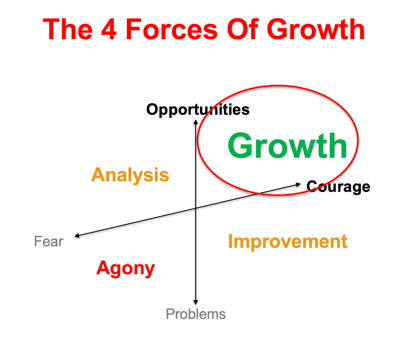
To pull this together, with the 4 Forces of Growth model:
If you’re really serious about growth, you want to concentrate your capital and human capital allocation to some degree (depending on your business) on the Growth quadrant, where the best work happens. You want to be further onto the right-hand side of the quadrant for the R&D dollars to have the biggest impact – and to balance it with Improvements, as needed.
You have to have enough energy and win frequently in order to keep that growth going. And, you cannot let pennies congest the system because we can so easily get stuck chasing pennies or nickels, and then wonder why growth isn't happening.
Final thought
We often start a new project based on a hypothesis of how things will work and what the benefit will be. That's why a rear-view, after-action review process is critical to evaluate your early thinking of what you thought these opportunities and benefits were. Look back and see what you actually manifested, quarter on quarter or even a few years down the road, versus what you initially thought, to improve your thinking and your ability to make better choices going forward.
The Challenge
- In which Dollar-sized opportunities (or problems) do you need to invest more organizational energy?
- In what Penny- or Nickel-sized opportunities (or problems) do you need to have people stop or minimize their energy?
Annual Check-Up
“You can’t be your strongest without the brutal truth.” - Chapter 9, Your Oxygen Mask First
I haven’t met many people who love going to the doctor or dentist but almost everyone knows that annual checkup to assess your health is necessary.
One of the most important habits, to keep companies I work with around the world from getting complacent on potentially dangerous issues, are annual checkups. Sometimes more often or less, depending on the company leadership.
We keep it simple:
- Before quarterly planning sessions, we do a quick 7- to 10-question Issues and Opportunities survey of executives, leaders and front-line employees. The results give us a sense of the sentiment in the company and clarify the tough issues that need to be on the table. It saves a ton of time, helps us to do our job better and ensures we don’t just do surface work.
- We add an outstanding 8-question assessment to help us to understand leadership behaviours, and if they are improving performance or eroding the company from the inside out. The correlation of the assessment results to their function or dysfunction is uncanny.
- 360 reviews on CEO and key leaders. For simplicity and impact, we ask between 9 and 12 questions for perspective on how well the leaders are doing, how they live core values and how they could be notably more effective. We’re not fans of long, statistical 360 ratings - we go for tangible examples.
For more weighty situations, or to help accelerate the growth of a high performer, we may go for deeper insights by interviewing 6 to 10 other people, who work with that leader.
Convert Insight to Action
In all cases, we make sure the information gathered is pulled it into plans for growth of individuals and the company, that we close the loop, and thank the people who gave us their time and energy giving us feedback.
Feedback can make people nervous but getting the truth on the table helps them to be more effective, sustains the good things they do and ensures the adjustments they need to improve.
As a leader, you have a choice about whether to learn about all the good and bad things going on. But if you keep pushing ahead without knowing, there’s always a serious long-term price to pay for the short-term bliss of avoidance.
The Challenge
- When was the last time you and your organization had a good checkup?
PS For further insights on the value of 360 feedback, I encourage you to read Chapter 9 of my book (Get Tough Feedback).
PPS Let us know if we can help you to gather more valuable insights about your company or leaders.
The 4 Forces of Growth
We’re about a third of the way through this year, and it feels as if we’ve already burned a year’s worth of energy. Many people have slipped into troubleshooting, problem solving and pivoting within their businesses and I’ve seen some amazing ways that teams have rallied to change, improve and come out stronger and more unified. It’s incredibly impressive.
So, now that we've made it through this initial storm, the key is to make sure that we become masters of prioritizing and focusing on what matters most. Unfortunately, when things become more chaotic - as they likely will be for a while – and there are many different perspectives and opinions, people often put their energy where their logic tells them. And they won't find out, until a few months down the road, that it might not have been the best choice. That’s when the difference between strategic thinkers and amazing executers start to show up.
Some people, for whatever reason, are better at figuring out the higher impact places to put their energy, and what to leave alone. Whether this is you, or not, the key is to have the right tools to help you and your team pick what matters the most - and to ensure you don’t get distracted and deluded by logical thought in an illogical time.
Defying Logic
From the beginning of recorded history, there have been people who pursued ideas and actions that defied logic. Like Leonardo Da Vinci who conceived a flying machine well before the Wright brothers took to the sky, or scientists in the 1700s who began to think that disease was caused by micro-organisms rather than bad blood or bad air.
These unique people were drawn to hard, risky pursuits that contained very little instant gratification and, in many cases, sustained struggle and sacrifice. They were motivated and inspired by the impact of their pursuits and had the courage to push ahead - even when the logic of the day told them otherwise.
Last August, I started work on a new book about this topic and, little did I realize that it would become incredibly important six months later. The premise of the book is to find a simple way to help people to evaluate their decisions – to truly understand if their priorities really help or hinder their growth.
I’m fascinated by people who do the unthinkable and continue to defy logic, to persevere and succeed. After much research, I chose the analogy of flight and the pilots who defy gravity for extended periods of time. CEOs and pilots are very similar, both from a leadership perspective and they ways they make amazing things happen.
The 4 Forces of Growth
In an airplane, pilots have to pay attention to the principles of flight – Lift, Thrust, Weight and Drag:

- Lift is created by the wings and contrasted by the weight of the plane and gravity. When you get lift and thrust you get altitude
- The thrust of the engines pushing the plane forward is fought by drag, the resistance of air.
Pilots - just like a CEO – must pay attention to these principles or they’ll quickly succumb to the forces of gravity.
Here’s how this relates to the world of a CEO and leader:
- Lift happens when leaders lift their heads to look at opportunities – the future possibilities that help the business to get to a higher altitude of more revenue, more customers, more profit
- Weight are the problems we get sucked into
- Thrust is the courage to push ahead, make decisions and get into action
- Drag is fear and doubt as we spend too much time contemplating, delay decisions and are less likely to act boldly.
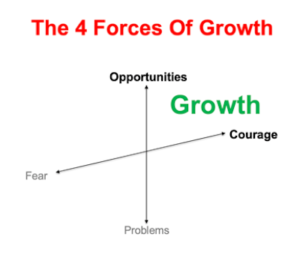
Opportunities and Problems, Fear and Courage are the 4 Forces of Growth that shape and define four states we can find ourselves in, at any given time: Agony, Analysis, Growth and Improvement.
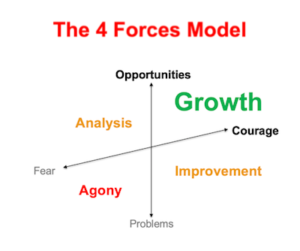
- Growth is the result of courage and opportunity: increased revenue, new customers, new products, new services, new markets. It’s solving a problem for somebody new or solving a new problem for someone you already work with. It's not about doing what you already do today – it’s about expanding in some way.
Growth is the accountability of CEOs who should be spending most of their thinking and action time in that box. And if the CEO is not, it’s very difficult for the company to grow.
- Improvement is when you have the courage to move ahead but your energy is focused on solving problems. While improvement is good, it won't grow a business on its own. It can make customers happier, improve margins and costs, and streamline operations. It's wonderful and equally dangerous.
This box is normally owned by the COO who needs to be focused on making things better. The challenge here is understanding the problems that need to be solved and the problems that need to be ignored. Knowing how to make the decision on which problem to focus, or not, is the value of an amazing CEO or COO. (We'll talk more about this, in future.)
You could stay in this box all day long and that's the risk because problems never go away. In many companies we work with, that are really focused on growth, we leave a couple of percent in the expense structure of the business for problems that we continue to pay for, so that we can reallocate more energy into growth. These are strategic decisions that generally only a good CEO can make - to not solve problems and to not optimize all their costs so that they can grow healthily and quickly.
- Analysis is on the other side of courage. This is where you look at opportunities but you're fearful or hesitant to make a decision. This box is generally mastered by the CFO – the yin to the CEOs yang - who challenges and throws reality and practicality at some of the CEOs strategy thinking. That's why the CEO or CFO pairing is so critical.
A certain amount of analysis is very good. We need it but, at a certain point, we also need to make a decision, a test or a move, so only being an analysis obviously isn't good. The question is how much do we need?
Depending on the CEO, this can vary. If you have a very growth-oriented, visionary CEO more analysis is often needed for balance. And a fairly analytical CEO might not lead as much on the CFO for additional analysis.
- Agony happens when you're a fearful victim, stuck in problems, and indecisive. This is analysis paralysis – a very painful place where problems become overwhelming and you can’t find your way out. This is possibly the most dangerous state of all because it can degrade the mental health of individuals, of teams and, in a worst-case scenario, the entire company.
To move across the line into improvement, you need to find – or borrow or rent - the courage to do something.
Generally, audit/legal/compliance own this box, and they need to look at problems, in order to keep us from getting into trouble. While we need to be compliant, and aware of the problems that can really hurt us, we also need to make decisions and move ahead. You don't grow a business here.
A Matter of Time
As you look at this model, where is your time spent?
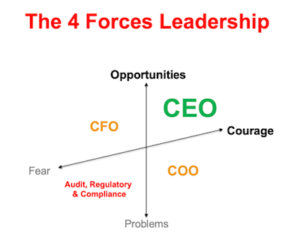
Some CEOs would say they want to be 80% growth, 9% analysis, 9% improvement and 2% agony. And others - depending on the state of their business and the strength of their team - might be 40% growth, 10% analysis, 40% improvement and 10% agony.
While there’s no right answer here, the key is being conscious of where you and your team actually spend your time, and to make sure your focus is in the right place.
The reality is that you just can’t expect to have a company that grows 30% per year, year on year, if the CEO spends 10% of their time in the growth box.
Red Flags
When we do strategic planning sessions with companies, we always try to make sure there's enough energy allocated to the Growth box for the company to reach its goals. And, obviously, we're always analyzing and improving things, in the business, so that it gets stronger as it gets bigger.
A red flag is when the CEO of a growing company spends too much time administering or analyzing their business, versus doing the things that create growth.
Sometimes these are easy distractions that may create a lot of noise and seem important, but they aren’t the best use of your time.
In our next blog post, we’ll dig further into the right-hand side of model: how to know in which of your growth opportunities and your improvement opportunities you should invest – and which to ignore.
The Challenge
- Think about how much time you spend in the growth box. What would be ideal?
- How much time do you spend in the improvement, analysis and agony boxes?
- Now think about your team. How much of your time do they spend in these areas and what would be ideal?





